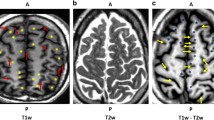Abstract
Thirteen brain regions were dissected from both hemispheres of fifteen ‘normal’ ageing subjects (8 females, 7 males) of mean age 79±7 years. Elemental compositions were determined by simultaneous application of particle induced X-ray emissions (PIXE) and Rutherford backscattering (RBS) analyses using a 2 MeV, 4nA proton beam scaned over 4 mm2 of the sample surface. Elemental concentrations were found to be dependent upon the brain region and hemisphere studied. Hierarchical cluster analysis was applied to group the brain regions according to the sample concentrations of eight elements. The resulting dendrogram is preseted and its clusters related to the sample compositions of grey and white matter.
Similar content being viewed by others
References
J. D. Stedman, N. M. Spyrou, Nutrition Supplement, 2 (1995) 542.
Y. Muramatsu, R. M. Parr, Survey of Currently Available Reference Materials for Use in Connection with the Determination of Trace Elements in Biological and Environmental Materials, International Atomic Energy Agency, Vienna, IAEA/RL/128.
Author information
Authors and Affiliations
Rights and permissions
About this article
Cite this article
Stedman, J.D., Spyrou, N.M. Hierarchical clustering into groups of human brain regions according to elemental composition. J Radioanal Nucl Chem 236, 11b–14 (1998). https://doi.org/10.1007/BF02386309
Received:
Issue Date:
DOI: https://doi.org/10.1007/BF02386309




